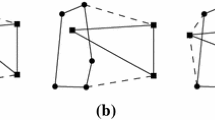Abstract
The Hausdorff Voronoi diagram of clusters of points in the plane is a generalization of Voronoi diagrams based on the Hausdorff distance function. Its combinatorial complexity is \(O(n+m)\), where n is the total number of points and \(m\) is the number of crossings between the input clusters (\(m=O(n^2)\)); the number of clusters is k. We present efficient algorithms to construct this diagram following the randomized incremental construction (RIC) framework (Clarkson and Shor in Discrete Comput Geom 4:387–421, 1989; Clarkson et al. in Comput Geom Theory Appl 3(4):185–212, 1993). Our algorithm for non-crossing clusters (\(m=0\)) runs in expected \(O(n\log {n} + k\log n \log k)\) time and deterministic O(n) space. The algorithm for arbitrary clusters runs in expected \(O((m+n\log {k})\log {n})\) time and \(O(m+n\log {k})\) space. The two algorithms can be combined in a crossing-oblivious scheme within the same bounds. We show how to apply the RIC framework to handle non-standard characteristics of generalized Voronoi diagrams, including sites (and bisectors) of non-constant complexity, sites that are not enclosed in their Voronoi regions, empty Voronoi regions, and finally, disconnected bisectors and disconnected Voronoi regions. The Hausdorff Voronoi diagram finds direct applications in VLSI CAD.





Similar content being viewed by others
Notes
Other metrics, such as the \(L_p\) metric, are possible.
The time complexity claimed in Dehne et al. is \(O(n\log ^4{n})\), however, in reality the described algorithm requires \(O(n\log ^5{n})\) time (Maheshwari 2018).
To avoid confusion with Voronoi regions we use the term ranges in this paper.
Note that some of the new ranges of type (2) in fact consist of portions of two or more distinct old ranges. However, here we treat each such range as a group of ranges, as subdivided by old ranges. After the vertex lists of this group are found, it is easy to merge these ranges into a single range, and their vertex lists into a single list.
References
Abellanas M, Hurtado F, Icking C, Klein R, Langetepe E, Ma L, Palop B, Sacristán V (2001) The farthest color Voronoi diagram and related problems. In: 17th Eur. workshop on comput. geom. (EWCG), full version: Tech. Rep. 002 2006, Universität Bonn, pp 113–116
Aurenhammer F, Klein R, Lee DT (2013) Voronoi diagrams and Delaunay triangulations. World Scientific, Singapore
de Berg M, Cheong O, van Kreveld M, Overmars M (2008) Computational geometry—algorithms and applications, 3rd edn. Springer, Berlin
Boissonnat JD, Yvinec M (1998) Algorithmic geometry. Cambridge University Press, New York
Cheilaris P, Khramtcova E, Langerman S, Papadopoulou E (2016) A randomized incremental algorithm for the Hausdorff Voronoi diagram of non-crossing clusters. Algorithmica 76(4):935–960
Chen DZ, Huang Z, Liu Y, Xu J (2013) On clustering induced Voronoi diagrams. In: 2013 IEEE 54th annual symposium on foundations of computer science (FOCS). IEEE, pp 390–399
Cheong O, Everett H, Glisse M, Gudmundsson J, Hornus S, Lazard S, Lee M, Na HS (2011) Farthest-polygon Voronoi diagrams. Comput Geom 44(4):234–247
Clarkson K, Shor P (1989) Applications of random sampling in computational geometry II. Discrete Comput Geom 4:387–421
Clarkson KL, Mehlhorn K, Seidel R (1993) Four results on randomized incremental constructions. Comput Geom Theory Appl 3(4):185–212
Claverol M, Khramtcova E, Papadopoulou E, Saumell M, Seara C (2018) Stabbing circles for sets of segments in the plane. Algorithmica 80(3):849–884
Dehne F, Maheshwari A, Taylor R (2006) A coarse grained parallel algorithm for Hausdorff Voronoi diagrams. In: 35th ICPP, pp 497–504
Edelsbrunner H, Guibas L, Sharir M (1989) The upper envelope of piecewise linear functions: algorithms and applications. Discrete Comput Geom 4:311–336
Huttenlocher DP, Kedem K, Sharir M (1993) The upper envelope of Voronoi surfaces and its applications. Discrete Comput Geom 9:267–291
Klein R (1989) Concrete and abstract Voronoi diagrams, (Lecture Notes in Computer Science), vol 400. Springer
Klein R, Mehlhorn K, Meiser S (1993) Randomized incremental construction of abstract Voronoi diagrams. Comput Geom 3(3):157–184
Maheshwari A (2018) private communication
Papadopoulou E (2011) Net-aware critical area extraction for opens in VLSI circuits via higher-order Voronoi diagrams. IEEE Trans CAD Integr Circuits Syst 30(5):704–717
Papadopoulou E (2004) The Hausdorff Voronoi diagram of point clusters in the plane. Algorithmica 40(2):63–82
Papadopoulou E, Lee DT (2004) The Hausdorff Voronoi diagram of polygonal objects: a divide and conquer approach. Int J Comput Geom Appl 14(6):421–452
Seidel R (1998) The nature and meaning of perturbations in geometric computing. Discrete Comput Geom 19(1):1–17
Voronoi CAA: Voronoi Critical Area Analysis. IBM VLSI CAD Tool, IBM Microelectronics Division, Burlington, VT, distributed by Cadence. Patents: US6178539, US6317859, US7240306, US7752589, US7752580, US7143371, US20090125852. Distributed by Cadence since 2007
Author information
Authors and Affiliations
Corresponding authors
Additional information
Research supported in part by the Swiss National Science Foundation, projects SNF 20GG21-134355 (ESF EUROCORES EuroGIGA/VORONOI) and SNF 200021E-154387. E. A. was also supported partially by F.R.S.-FNRS and SNF grant P2TIP2-168563 under the SNF Early PostDoc Mobility program.
E. Arseneva: Research performed mainly while at the Università della Svizzera italiana (USI).
Rights and permissions
About this article
Cite this article
Arseneva, E., Papadopoulou, E. Randomized incremental construction for the Hausdorff Voronoi diagram revisited and extended. J Comb Optim 37, 579–600 (2019). https://doi.org/10.1007/s10878-018-0347-x
Published:
Issue Date:
DOI: https://doi.org/10.1007/s10878-018-0347-x




